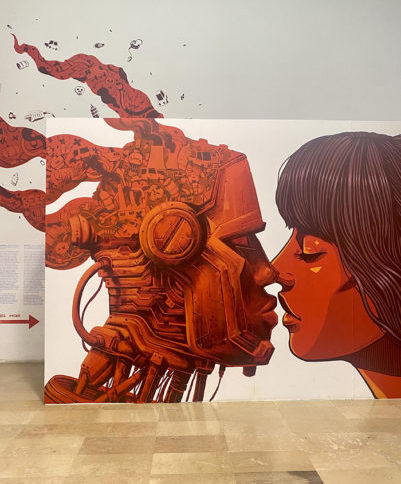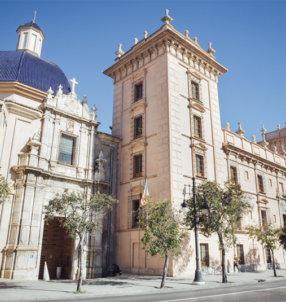In Valencia, the ‘Centre del Carme de Cultura Contemporania’ (or CCCC for short), is currently exhibiting ‘Emergency on Planet Earth’. Over four months on from its inauguration, the exhibition may hold greater meaning for its visitors. With the heatwave swarming its way around Europe, the warnings that the exhibition gives us feel increasingly pressing. The emergency is becoming blatant, and harder to ignore.
If you take one look at the news today, it is ridden with examples of how climate change is now affecting us in the form of this heatwave. There have been wildfires in France, Portugal, Spain, and Greece, with London being a recent addition to the list. In Spain and Portugal, more than 1000 deaths have been attributed to heat in recent days. The MET Office estimates that the extreme heat we are seeing over these next couple of days has been made ten times more likely due to climate change.
Of course, this was all predicted several years ago. Climate scientists have been sharing evidence of these temperature changes for a while. Dr Friederike Otto from Imperial College London today has said ’40 °C at Heathrow would have been extremely unlikely or virtually impossible without human-caused climate change. It’s now an event that shouldn’t have surprised anyone. Whilst still rare, 40 °C is now a reality of British summers’.
She adds the further comment that ‘it is in our hands whether every future heatwave will continue to be extremely deadly and disruptive’.
These comments, in line with ‘Emergency on Planet Earth’, emphasise the urgent need for action, whilst also pointing out collective responsibility. As you walk into the exhibition, you are first confronted with an image labelled ‘the kiss of death’. The painting, emboldened in bright red, shows a human woman kissing a man who is supposed to embody the death of humanity. He appears robotic in form, made up of mechanical parts – perhaps a jab at humanity’s supposed monotony when it comes to acting. The text coming alongside this painting highlights the temptation for humanity to close their eyes and ignore the evidence being placed before them. It is accusing in a way that makes the spectator themselves complicit – we know what will happen if we do not do something now and that we have already passed a lot of terrifying limits.
As you pass into the second room, you find yourself completely immersed by a painting on all four walls. Surrounded by melting glaciers, polar bears, fire, and smoke in what appears to be a climate change apocalypse, the painting is certainly striking. This is the room that speaks about global warming. Frozen water, melting icebergs, dried up lakes and forest fires. It seems like a bleak utopia of the future, but in reality it happens every day somewhere on this planet.
Beyond these first two rooms are an abundance of many other rooms that cover individual themes. The ones that are covered include space debris, overpopulation, fossil fuels and loss of biodiversity. Loss of biodiversity is a particularly poignant one. Rows of small gravestones carry the names of animals at risk of extinction, in the format ‘Hello, my name was….’. The childlike pictures of the animals on the blocks cleverly juxtapose the coldness of the scene itself, the conversion of animal to object symbolising the materialism of the corporate world. The accompanying text reads this piece represents ‘end of days capitalism’ when corporations will have wrung every last drop of life out of all the world’s resources.
You may have noticed, as I did when walking through the exhibition myself, the hard-lined messages it sends. The language of the texts leaves no room for excuses or the admonishing of responsibility. The need to decrease global carbon emissions have been acknowledged through the United Nation’s net zero policy that aims to halve emissions by 2030 and achieve net zero by 2050. However, commitments made by governments so far fall short of where we need them to be in order to achieve those goals. Emissions are expected to have increased by 14% in 2030, as opposed to being reduced at all. With this in mind, it is understandable why ‘Emergency on Planet Earth’ adopted a firm hand.
As the exhibition itself acknowledges, it is not the first of its kind and will not be the last. We already have all of the information that we need in order to halt things, but what ‘Emergency on Planet Earth’ tries to do is get us to stop talking and actually start doing.
Report by Anusha Vasudeva
Article copyright ‘24/7 Valencia’
Photo copyright Anusha Vasudeva / ’24/7 Valencia’
For more information on net zero, please visit https://www.un.org/en/climatechange/net-zero-coalition
‘Emergency on Planet Earth’ will continue until the 4th of September. Entry is free. The CCCC is open from Tuesdays – Sundays, 11:00 until 21:00.
‘Centre del Carme de Cultura Contemporania’
Carrer del Museu, 2, 4
46003
Valencia
Tel. 963 152 024 / 961 922 642
From Tuesday to Sunday
from 11:00h to 21:00 h.
consorcidemuseus@gva.es
Website: https://www.consorcimuseus.gva.es/centro-del-carmen/
Related Post
This site uses Akismet to reduce spam. Learn how your comment data is processed.

























Leave a comment